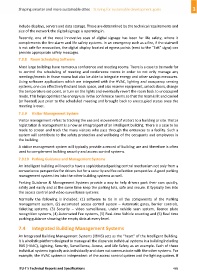Page 499 - Shaping smarter and more sustainable cities - Striving for sustainable development goals
P. 499
include displays, servers and data storage. These are determined by the technical requirements and
size of the network the digital signage is operating in.
Recently, one of the most innovative uses of digital signage has been for life safety, where it
complements the fire alarm and life safety systems. In an emergency such as a fire, if the stairwell
is not safe for evacuation, the digital display located at egress points (next to the “Exit” signs) can
provide appropriate safety messages.
7.3.8 Room Scheduling Software
Most large buildings have numerous conference and meeting rooms. There is a case to be made for
to control the scheduling of meeting and conference rooms in order to not only manage any
meetings/events in those rooms but also be able to integrate energy and other savings measures.
Using software applications which are integrated with the HVAC, lighting and occupancy sensing
systems, one can effectively find and book space, and also reserve equipment, unlock doors, change
the temperature set‐point, or turn on the lights and eventually revert the room back to unoccupied
mode. This helps optimize the energy use in the conference rooms so that the room is lit and cooled
(or heated) just prior to the scheduled meeting and brought back to unoccupied status once the
meeting is over.
7.3.9 Visitor Management System
Visitor management refers to tracking the use and movement of visitors to a building or site. Visitor
registration & management is a now an integral part of an intelligent building. There is a case to be
made to screen and track the many visitors who pass through the entrances to a facility. Such a
system will contribute to the safety protection and wellbeing of the occupants and employees in
the building.
A visitor management system will typically provide a record of building use and therefore is often
used to complement building security and access control systems.
7.3.10 Parking Guidance and Management Systems
An intelligent building will need to have a sophisticated parking control mechanism not only from a
convenience perspective for drivers but for a security and fee collection perspective. A good parking
management system ties into the other building systems as well.
Parking Guidance & Management Systems provide a way to help drivers park their cars quickly,
safely and easily and at the same time keep the parking lots, safe and secure. It typically ties into
the access control and video surveillance systems.
Normally the following is included: (1) software to tie in all the components of the Parking
management system, (2) automated access control system – Automatic gates, barrier controls,
ticketing systems, (3) Security – video surveillance, under vehicle scan system, licence plate
recognition systems, (4) Automated Fee systems, (5) Real‐time Vehicle counting and (5) Real time
parking guidance showing the empty slots at every level.
7.4 Integrated Building Management Systems
An Integrated Building Management Systems (IBMS) acts as the “heart” of the Intelligent Building.
It is a holistic platform designed to manage all the disparate individual systems in a building including
BAS (HVAC), Lighting, Security, Surveillance, Access, and Life Safety as an example. Each of these
individual systems typically acts individually and does not communicate with the other systems. For
example, the HVAC system is independent of the access control system and the lighting system. If
ITU‐T's Technical Reports and Specifications 489

